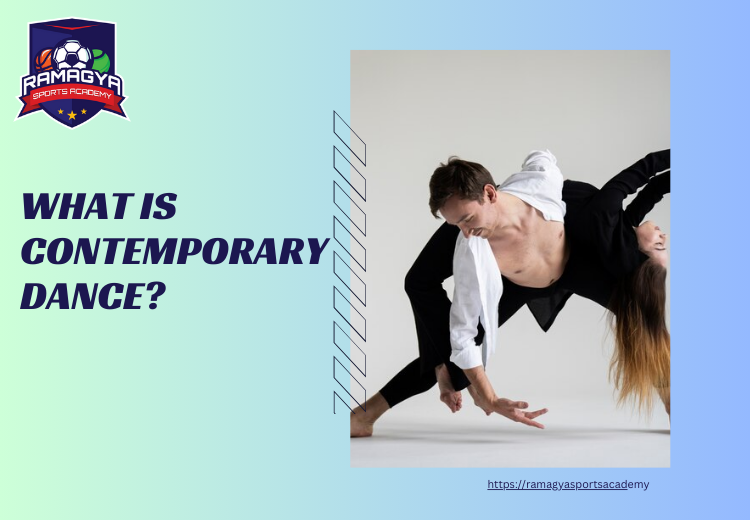
Rabeeb Ali Khan Secured 2nd Position and a Silver medal at the AITA National Ranking Championship
November 19, 2024
Shashvat Sachan Wins Gold at the 4th Kaikan Cup Open Karate Championship 2024
November 20, 2024What is Contemporary Dance?

Contemporary dance is a unique form that blends various movements and techniques into an expressive performance, emphasizing emotions and ideas through movement. As opposed to more traditional forms, contemporary dance allows dancers to explore more freely their bodies and the space around them, including ballet, jazz, and modern dance, contemporary dance is highly versatile.
Contemporary dance is highly adaptable and improvisatory techniques from each of these genres make each performance special and engage the audience while conveying stories and emotions through movement and inviting viewers to interpret and respond to its art as they see fit.
The Origins of Contemporary Dance
Contemporary dance first emerged as a movement within dance during the early 20th century as a reaction against more classical forms, specifically ballet. While ballet relied heavily on strict technique, contemporary dance allowed for greater freedom of movement and personal expression through personal expression through dance. Contemporary dance emerged due to pioneering choreographers exploring new ways of moving and telling stories through dance.
Isadora Duncan was one of the early innovators of contemporary dance. She believed dance should reflect natural body movements rather than rigid poses. She advocated fluidity and grace drawn from nature and everyday life as sources of inspiration. Martha Graham introduced dance as an expressive means to convey emotions and narratives by emphasizing natural body movements to communicate deeper feelings.
Contemporary Dance Today
Contemporary dance has never been more prevalent, appearing at theaters, dance festivals and public spaces alike. Dancers trained in various styles bring their unique voices to the art form while choreographers push boundaries by exploring themes, technologies and movement possibilities that open new horizons for choreographers and their dancers alike.
Dance companies around the world showcase contemporary works, often collaborating with artists from different disciplines, such as theater, music, and visual arts. This interdisciplinary approach enriches the experience for both performers and audiences, creating innovative and thought-provoking performances.
- A Fusion of Styles: The Eclectic Tapestry of Contemporary Dance
Contemporary dance is an exhilarating mix of different forms of movement that include ballet, jazz and modern dance components. This eclectic tapestry creates an exciting, dynamic art that allows dancers to transcend traditional boundaries while exploring new possibilities that come alive through movement. As opposed to classical ballet which can often be rigid in terms of technique and interpretation, contemporary dance is more flexible, celebrating creativity while providing dancers an outlet to demonstrate imagination through varied moves as well as gestures.
- The Power of Improvisation: Embracing Spontaneity in Contemporary Dance
Contemporary dance stands out as being unique because of its emphasis on improvisational techniques. Improvisation accelerates every performance with spontaneity and emotional depth, in stark contrast with choreographed routines of other dance forms. Contemporary dancers frequently participate in improvised patterns which allow them to respond instinctively to music, exploring depth of artistic inclinations while creating an air of uncertainty among audiences with spontaneity of dancers and freedom of expression.
- Embodying Narrative Through Movement: The Expressive Potential of Contemporary Dance
Dance is an effective means of storytelling, enabling dancers to convey stories while stirring emotions through movement. Combining movements, spatial dynamics and theatrical elements with dance performances, contemporary dancers bring abstract concepts and emotional issues alive for viewers through movement – whether it’s the loss of love or reflection on social issues; contemporary dancing allows audiences to engage emotionally in an experience through dance. Dancing in the present can also provide an effective means of conveying human emotion without words to make an emotional statement that resonates.
- The Evolution of Contemporary Dance Steps: Innovations and Boundless Creativity
Contemporary dancers’ step dance repertoire can be identified by its constant evolution as choreographers and dancers search for innovative ways to convey their ideas through dance. Ranging from delicate floor movements to rapid turns and leaps, contemporary dance steps showcase its infinite imagination and creativity inherent in this form of art. Dancers add personal interpretations into every move they perform bringing life and emotion to each performance they deliver.
Conclusion
At the conclusion of our lessons in contemporary dance steps, we hope that you have gained an increased awareness of its many artistic qualities. You may be inspired to begin dancing or simply marveled by its beauty. Contemporary dance steps provide us with endless opportunities for expression through art while honoring body language as a form of communication.
Let the stunning, mesmerizing beauty of contemporary dance inspire your imagination and awaken your senses as you immerse yourself in its dynamic world of expression and enthusiasm!
Frequently Asked Questions:
- Is contemporary dance good for beginners?
Yes! Contemporary dance is great for beginners. Many dance classes offer lessons for all skill levels, focusing on basic movements and encouraging creativity.
- How does contemporary dance promote physical fitness in children?
Contemporary dance involves various movements that enhance strength, flexibility, coordination, and endurance. Regular participation helps kids stay active and healthy.
- Can contemporary dance improve social skills in children?
Yes! Dance classes encourage collaboration and teamwork, helping kids build friendships and develop important social skills.
- Why is contemporary dance important for kids?
Contemporary dance is important for kids because it encourages creativity, confidence, and self-expression. It’s a fun way for them to explore their feelings and connect with others through movement.



